Soil Classification from Piezocone Penetration Test Using Fuzzy Clustering and Neuro-Fuzzy Theory
Abstract
:1. Introduction
2. Soil Classification Method for CPT and PCPT
2.1. Soil Classification Charts
2.2. Soil Classification Using Fuzzy Theory
2.2.1. Pradhan’s Study
2.2.2. Zhang and Tumay’s Study
3. Fuzzy Clustering and Neuro-Fuzzy Modeling
3.1. Database
3.2. FCM (Fuzzy C-Means) Clustering Algorithm
- ①
- Assume partition number c () and fuzziness of partition m.
- ②
- Select initial values of fuzzy partition matrix, . Random values are assumed for satisfying Equation (6).
- ③
- Calculate the center of cluster using Equation (8).
- ④
- Recompose fuzzy partition matrix using Equation (9).
- ⑤
- Complete the procedure if . Otherwise, repeat phase ④. Here, is assumed to be .
- ⑥
- Repeat phases ① to ⑤ and decide optimized partition number, as well as c and m values.
3.3. Neuro-Fuzzy Algorithm
- ①
- The neuro-fuzzy output shown in Figure 6 is defined as a first-order function as shown in Equation (10) if two input parameters are assumed. Here, p, q, and r are constants to be decided after neural network training, while and are input parameters, which are PCPT indices.
- ②
- Total outputs in the system considering weighting factors and are given by Equation (11). Weighting factors are calculated using Equation (12) after evaluating each fuzzy membership function for given input parameters. Here, corresponds to the finalized fuzzy membership function of , while corresponds to the finalized fuzzy membership function .
- ③
- The training procedure is completed after optimizing the parameters (, and ) of the first-order function and of membership functions to minimize output error, defined by output and estimation .
4. Verification of Suggested Neuro-Fuzzy Model
4.1. Busan New Port Site
4.2. Yangsan Site
4.3. Busan New Port Support Area Site
4.4. Jeonnam Dojang Port Site
4.5. Incheon Trade Center Site
4.6. Ulsan Southern Breakwater Site
5. Conclusions
- (1)
- FCM clustering of the local database suggested that three input parameters of qt, Rf, and Bq combined with three soil groups, i.e., clay, silt, and sand presented the highest success rate of 74.0%, and the m value representing the partition was optimized as 4.
- (2)
- The neuro-fuzzy model was developed on the basis of the FCM clustering results with three input parameters qt, Rf, and Bq and three output classes, i.e., clay, silt, and sand. The training procedure was performed with a total of 5173 data points using various combinations of fuzzy membership functions. As a result, a maximum success rate of 79.09% was shown when the triangular membership function for qt, Gaussian membership function for Rf, and sigmoidal membership function for Bq were applied.
- (3)
- Zhang and Tumay’s method revealed low applicability when the penetration pore pressure by piezocone was negative or the same as the hydrostatic pressure since this method does not consider the pore pressure as an input parameter. The two charts presented by Robertson et al. sometimes failed to classify the upper reclaimed sand layer and interbedded sand or silt layer. Since Pradhan’s method was adjusted to best match Robertson’s diagram, both methods tended to yield essentially similar soil classification results. However, since Pradhan’s method expressed a single soil classification using the overlapping fuzzy membership in Robertson’s two diagrams and limited the maximum value of the fuzzy membership to 0.8, the soil classification result from Pradhan did not always match that of Robertson et al.
- (4)
- The suggested neuro-fuzzy model matched well with boring logs and provided a better agreement with the classification in Korea. In addition, it has strong advantages in terms of revising or updating the model when the database is supplemented with new data.
Author Contributions
Funding
Institutional Review Board Statement
Informed Consent Statement
Data Availability Statement
Conflicts of Interest
References
- Begemann, H.K. The friction jacket cone as an aid in determining the soil profile. In Proceedings of the 6th International Conference on Soil Mechanics and Foundation Engineering, Montreal, QC, Canada, 8–15 September 1965; Volume 1, pp. 17–20. [Google Scholar]
- Douglas, B.J.; Olsen, R.S. Soil classification using electric cone penetrometer. Cone Penetration testing and Experience. In Proceedings of the ASCE National Convention, St. Louis, MO, USA, 26–30 October 1981; pp. 209–217. [Google Scholar]
- Robertson, P.K.; Campanella, R.G.; Gillespie, D.; Greig, J. Use of Piezometer Cone Data. In Proceedings of the ASCE Specialty Conference In Situ ’86: Use of In Situ Test in Geotechnical Engineering, Blacksburg, VA, USA, 23–25 June 1986; pp. 1263–1280. [Google Scholar]
- Robertson, P.K. Soil classification using the cone penetration test. Can. Geotech. J. 1990, 27, 151–158. [Google Scholar] [CrossRef]
- Jefferies, M.G.; Davies, M.P. Soil classification by the cone penetration test: Discussion. Can. Geotech. J. 1991, 28, 173–176. [Google Scholar] [CrossRef]
- Pradhan, T.B.S. Soil identification using Piezocone Data by Fuzzy Method. Soils Found. 1998, 38, 255–262. [Google Scholar] [CrossRef] [Green Version]
- Zhang, Z.; Tumay, M.T. Statistical to Fuzzy Approach toward CPT Soil Classification. J. Geotech. Geoenvironmental Eng. 1999, 125, 179–186. [Google Scholar] [CrossRef]
- Hegazy, Y.A.; Mayne, P.W. Objective Site Characterization using Clustering of Piezocone Data. J. Geotech. Geoenvirnomental Eng. 2002, 128, 986–996. [Google Scholar] [CrossRef]
- Tsiaousi, D.; Travasarou, T.; Drosos, V.; Ugalde, J.; Chacko, J. Machine Learning Applications for Site Characterization Based on CPT Data. In Geotechnical Earthquake Engineering and Soil Dynamics V: Slope Stability and Landslides; Laboratory Testing and In Situ Testing; American Society of Civil Engineers: Reston, VA, USA, 2018; pp. 461–472. [Google Scholar]
- Reale, C.; Gavin, K.; Librić, L.; Jurić-Kaćunić, D. Automatic classification of fine-grained soils using CPT measurements and Artificial Neural Networks. Adv. Eng. Inform. 2018, 36, 207–215. [Google Scholar] [CrossRef] [Green Version]
- Wang, H.; Wang, X.; Wellmann, J.F.; Liang, R.Y. A Bayesian unsupervised learning approach for identifying soil stratification using cone penetration data. Can. Geotech. J. 2019, 56, 1184–1205. [Google Scholar] [CrossRef]
- Kurup, P.U.; Griffin, E. Prediction of Soil Composition from CPT Data Using General Regression Neural Network. J. Comput. Civ. Eng. 2006, 20, 281–289. [Google Scholar] [CrossRef]
- Zhang, W.; Wu, C.; Zhong, H.; Li, Y.; Wang, L. Prediction of undrained shear strength using extreme gradient boosting and random forest based on Bayesian optimization. Geosci. Front. 2021, 12, 469–477. [Google Scholar] [CrossRef]
- Rauter, S.; Tschuchnigg, F. CPT Data Interpretation Employing Different Machine Learning Techniques. Geosciences 2021, 11, 265. [Google Scholar] [CrossRef]
- Oberhollenzer, S.; Premstaller, M.; Marte, R.; Tschuchnigg, F.; Erharter, G.H.; Marcher, T. Cone penetration test dataset Premstaller Geotechnik. Data Brief 2021, 34, 106618. [Google Scholar] [CrossRef] [PubMed]
- Robertson, P.K. Interpretation of cone penetration tests—A unified approach. Can. Geotech. J. 2009, 46, 1337–1355. [Google Scholar] [CrossRef] [Green Version]
- Robertson, P.K. Soil Behaviour Type from the CPT: An Update. In Proceedings of the 2nd International Symposium on Cone Penetration Testing, Huntington Beach, CA, USA, 9–11 May 2010. [Google Scholar]
- Robertson, P. Cone penetration test (CPT)-based soil behaviour type (SBT) classification system—An update. Can. Geotech. J. 2016, 53, 1910–1927. [Google Scholar] [CrossRef]
- Zadeh, L.A. Fuzzy sets. Inf. Control 1965, 8, 338–353. [Google Scholar] [CrossRef] [Green Version]
- Kim, C.H.; Im, J.C.; Kim, Y.S. Study on Applicability of CPT Based Soil Classification Chart. J. KSCE 2008, 28, 293–301. (In Korean) [Google Scholar]


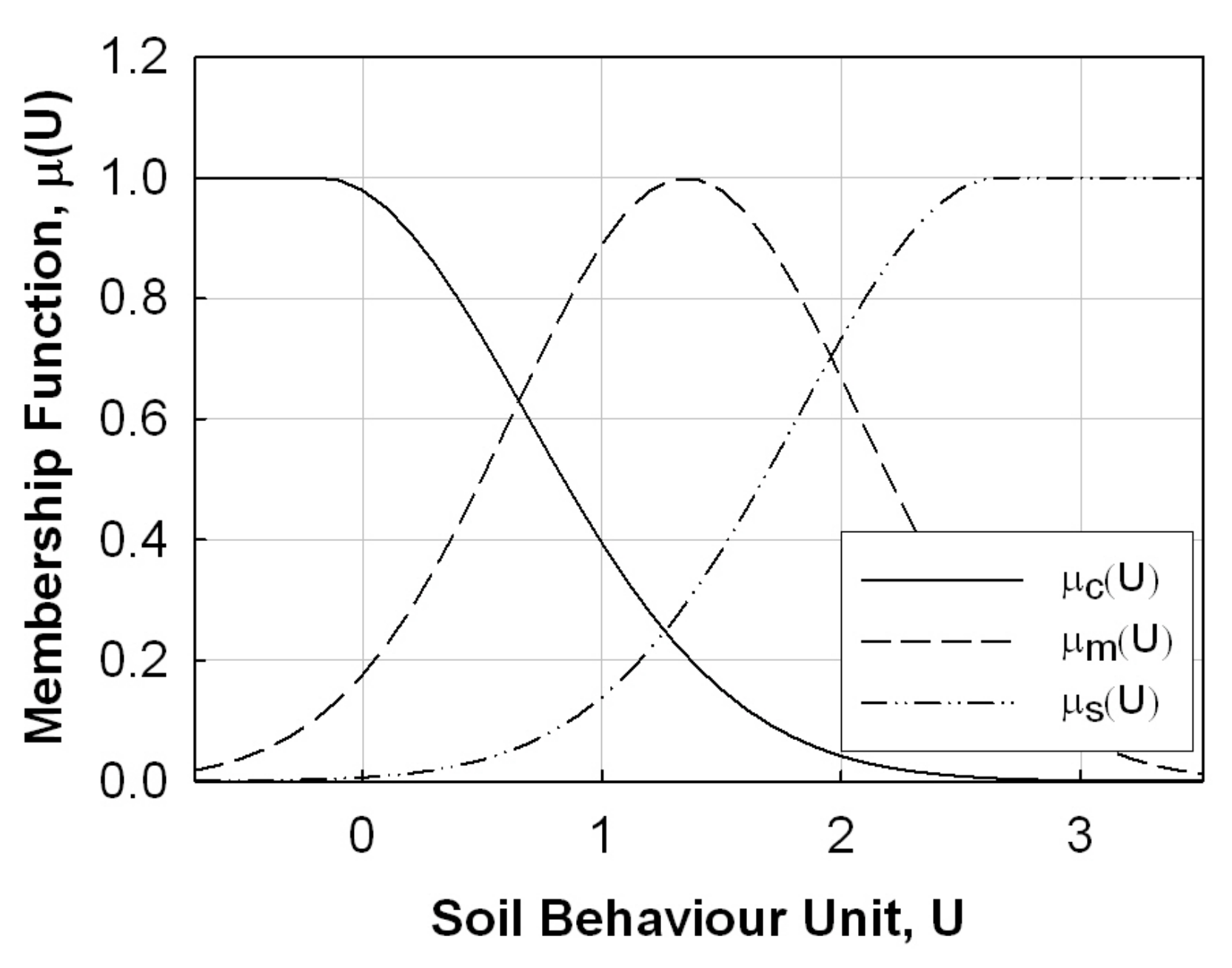
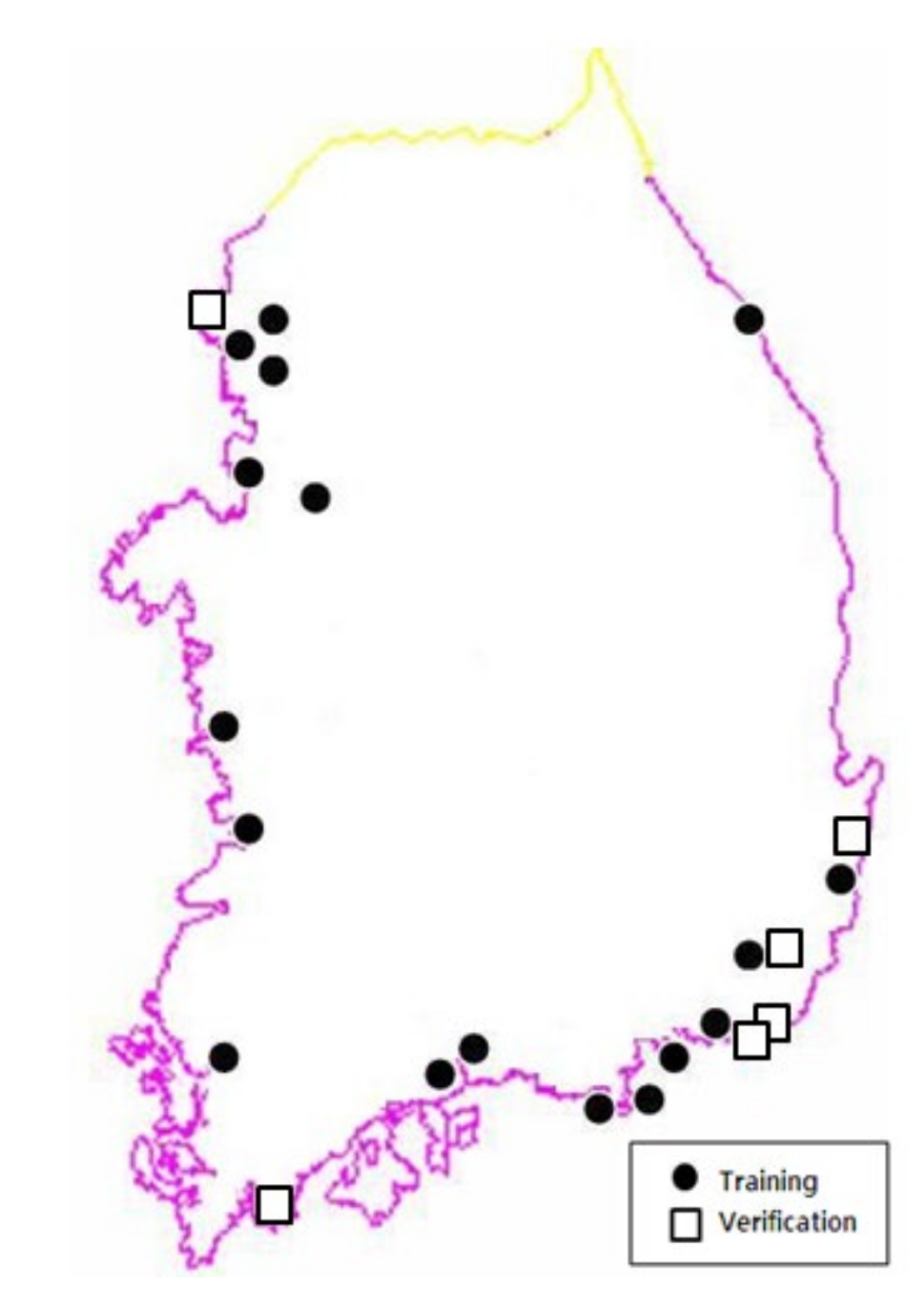

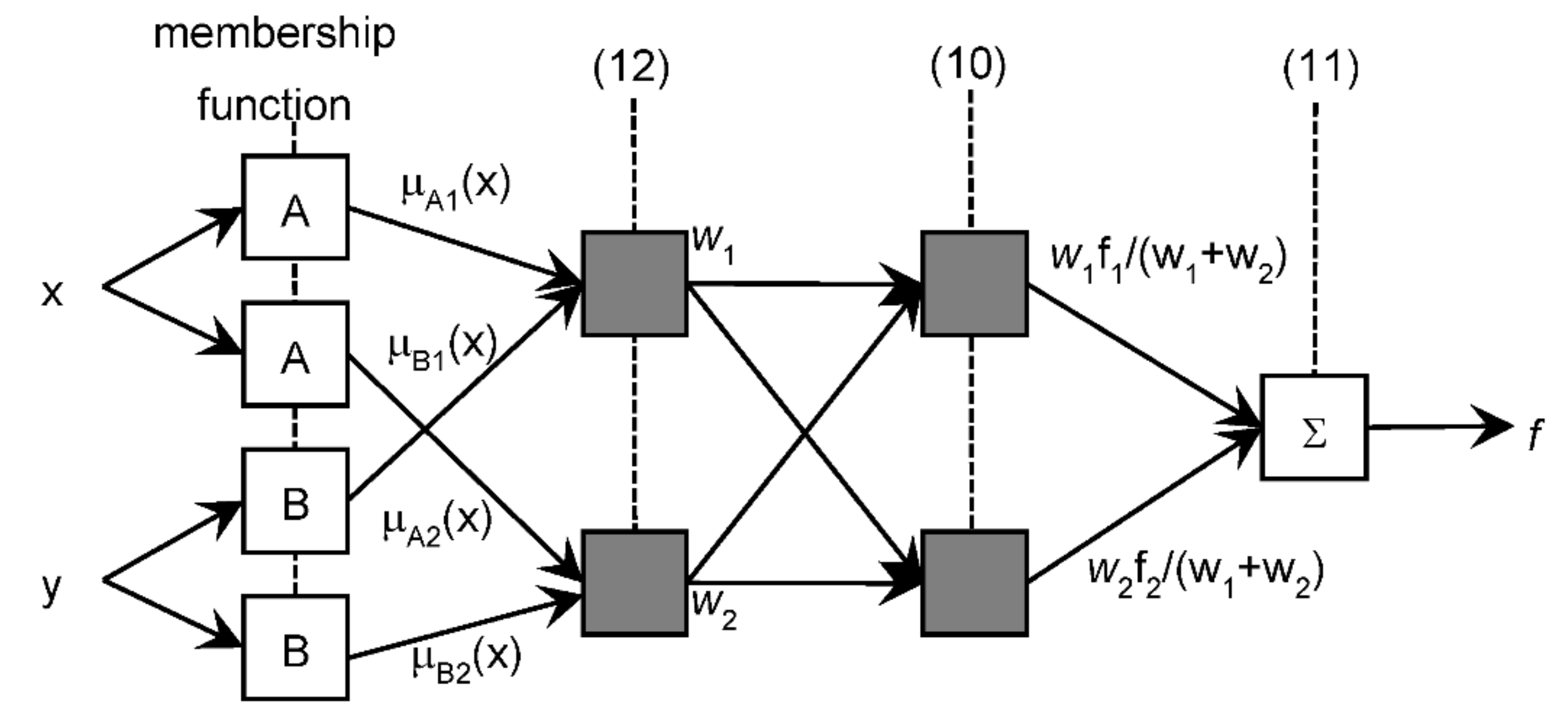
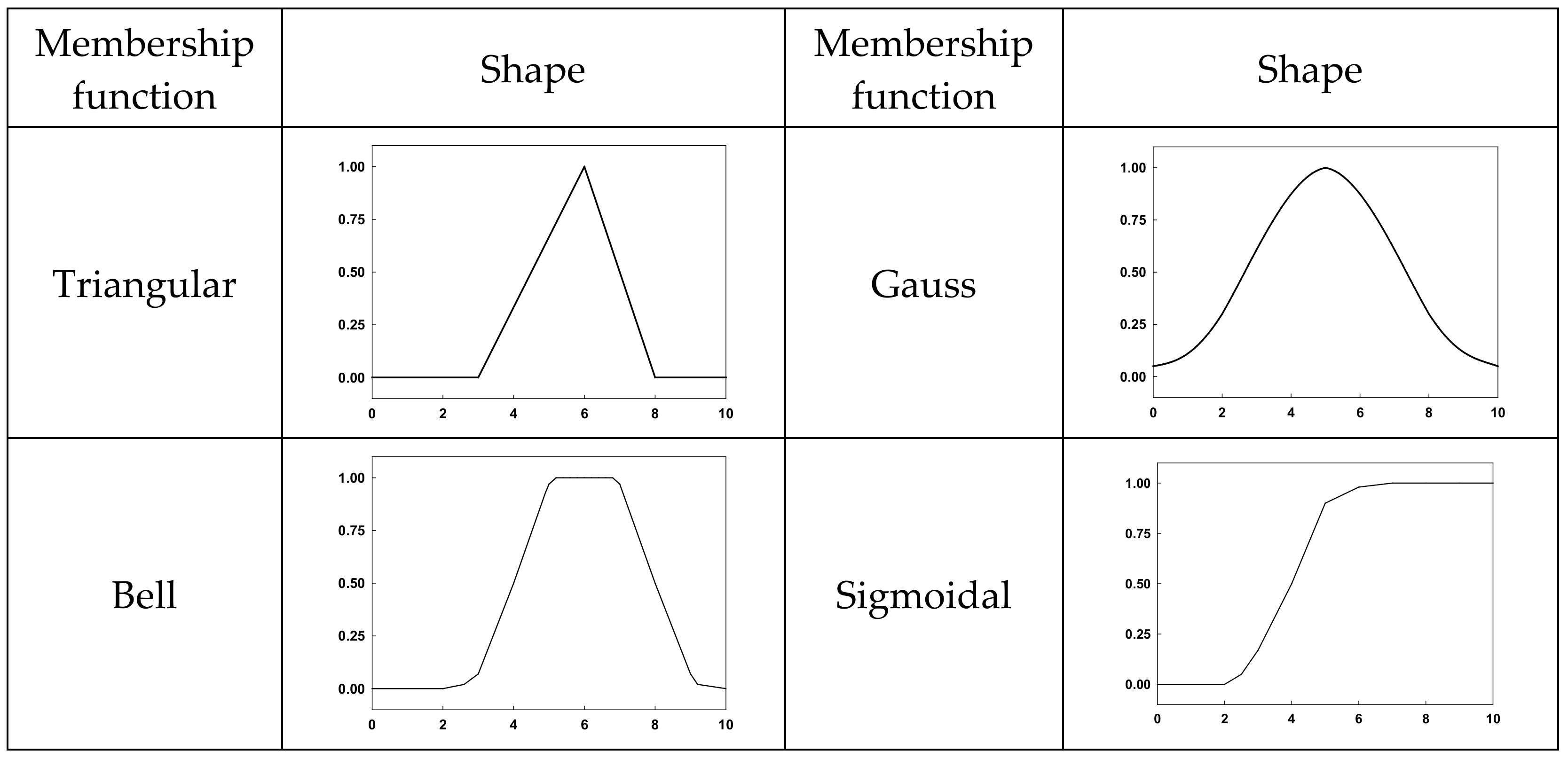

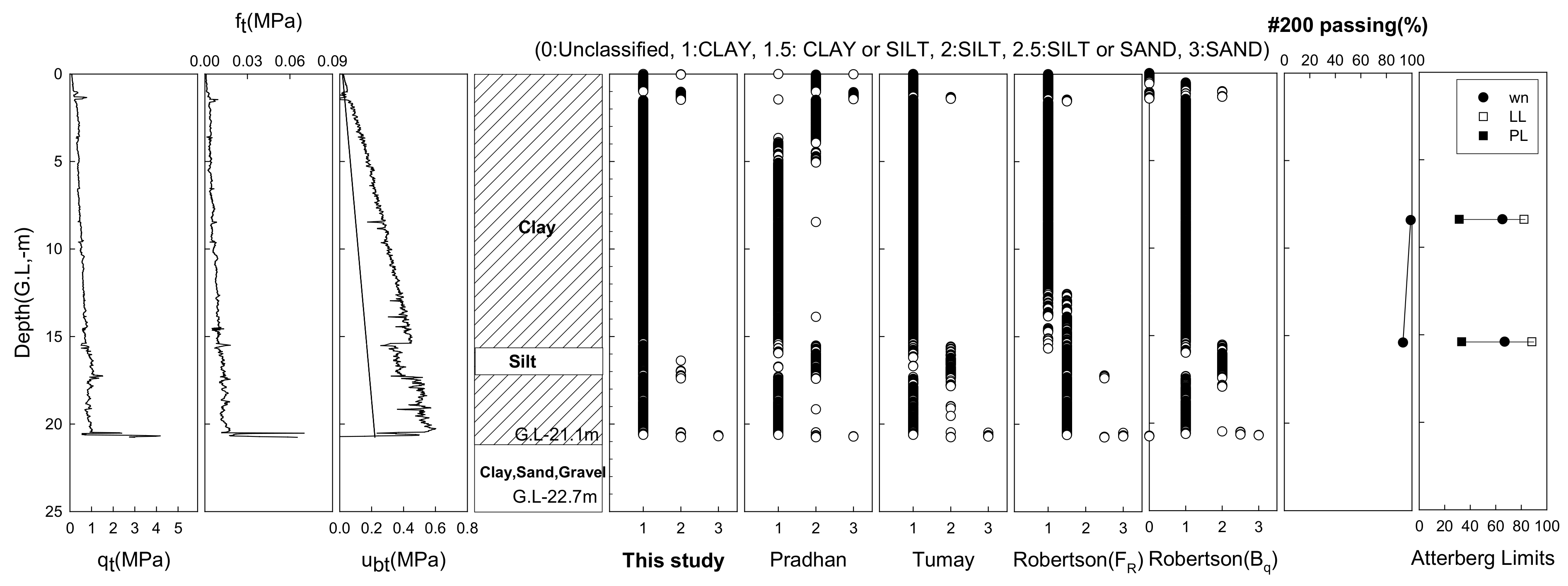

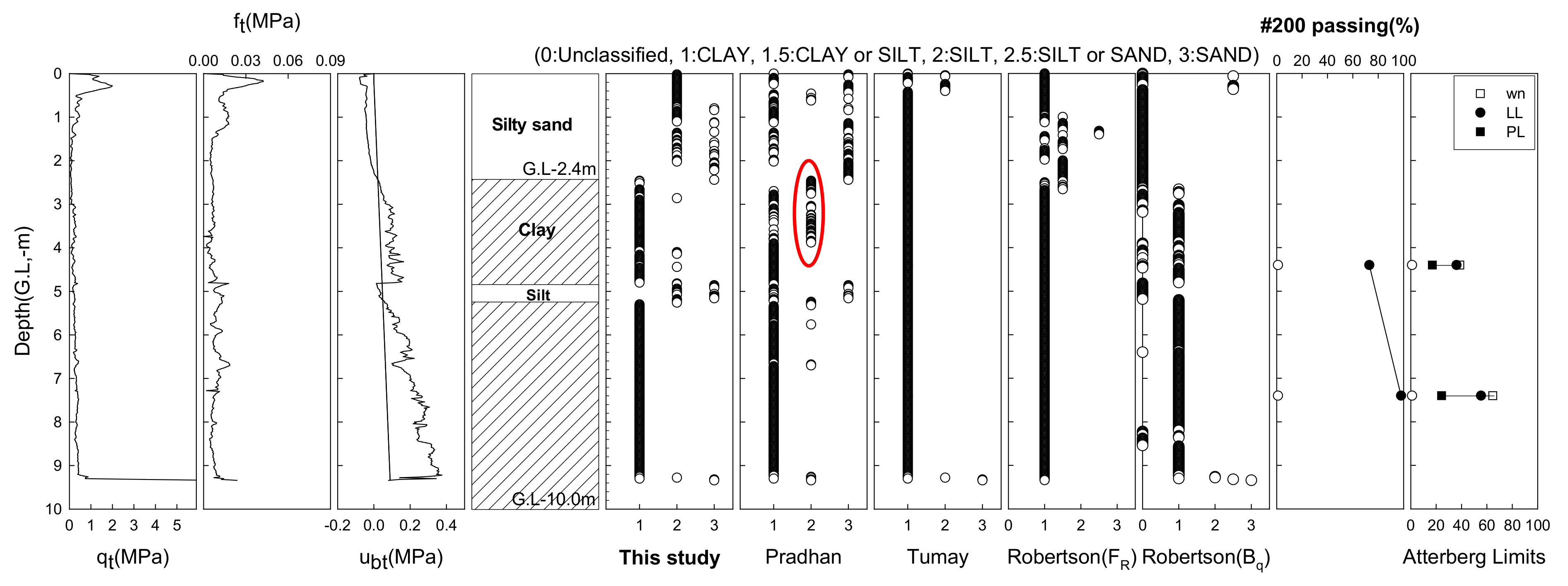
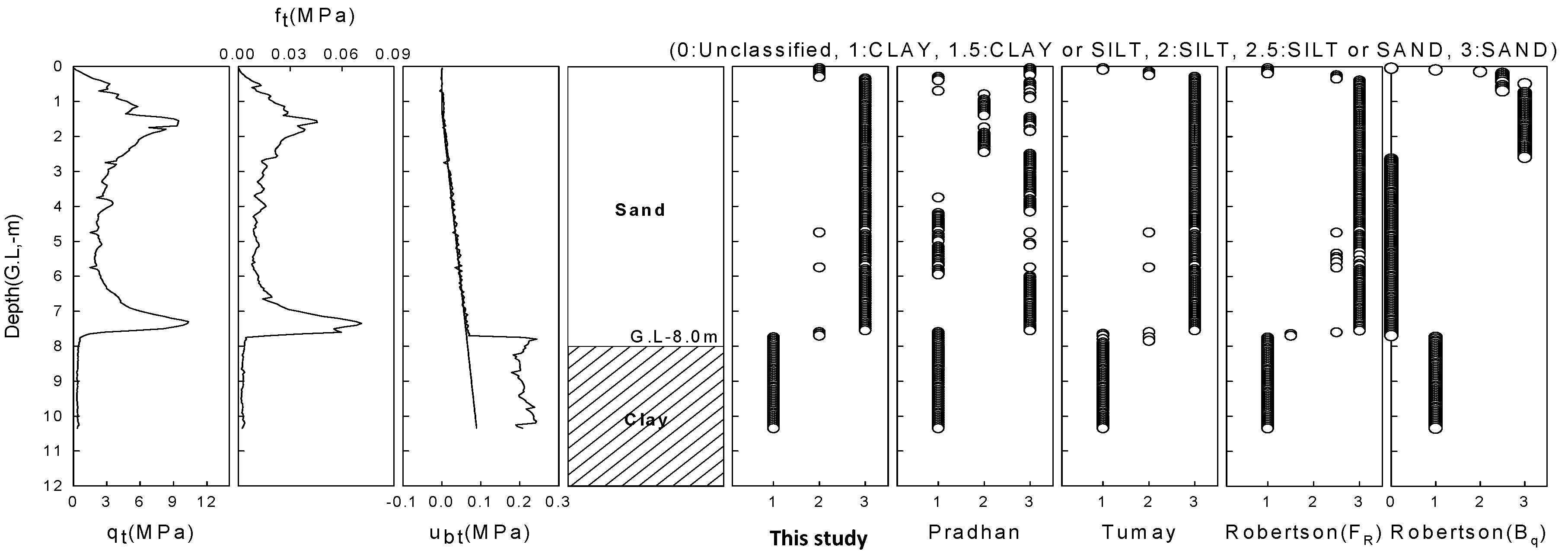
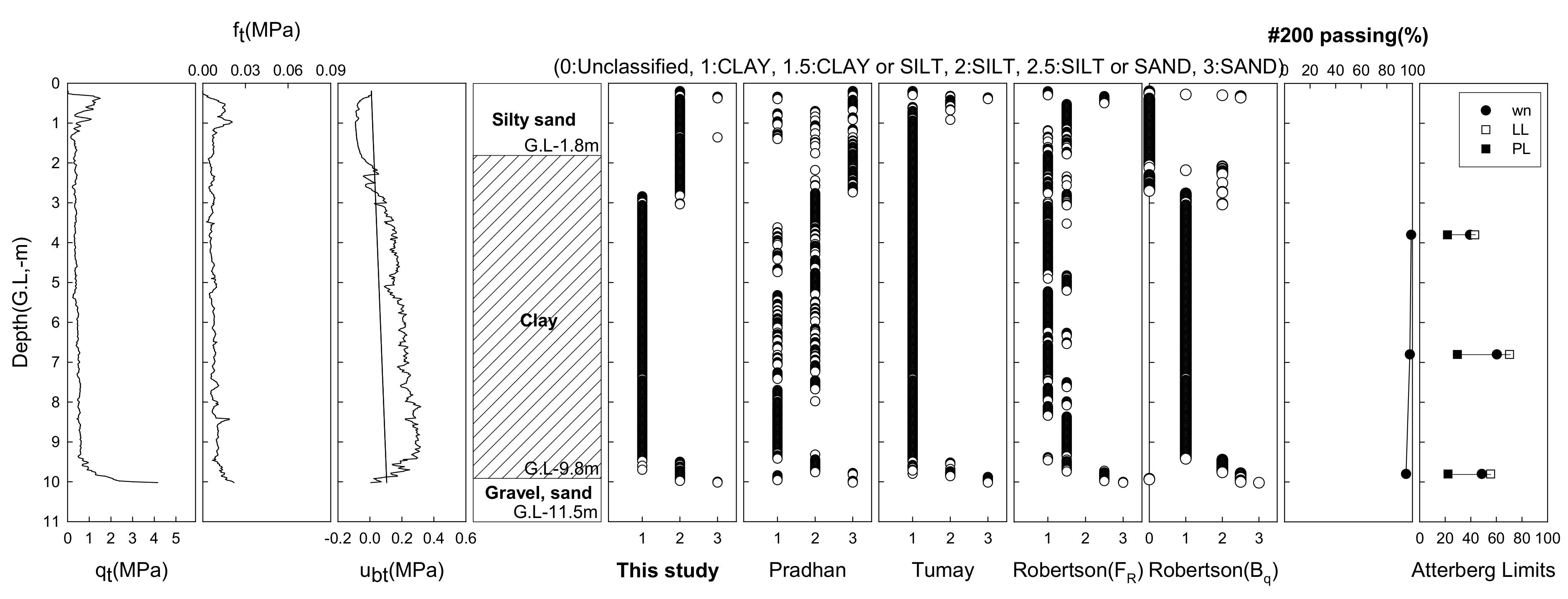
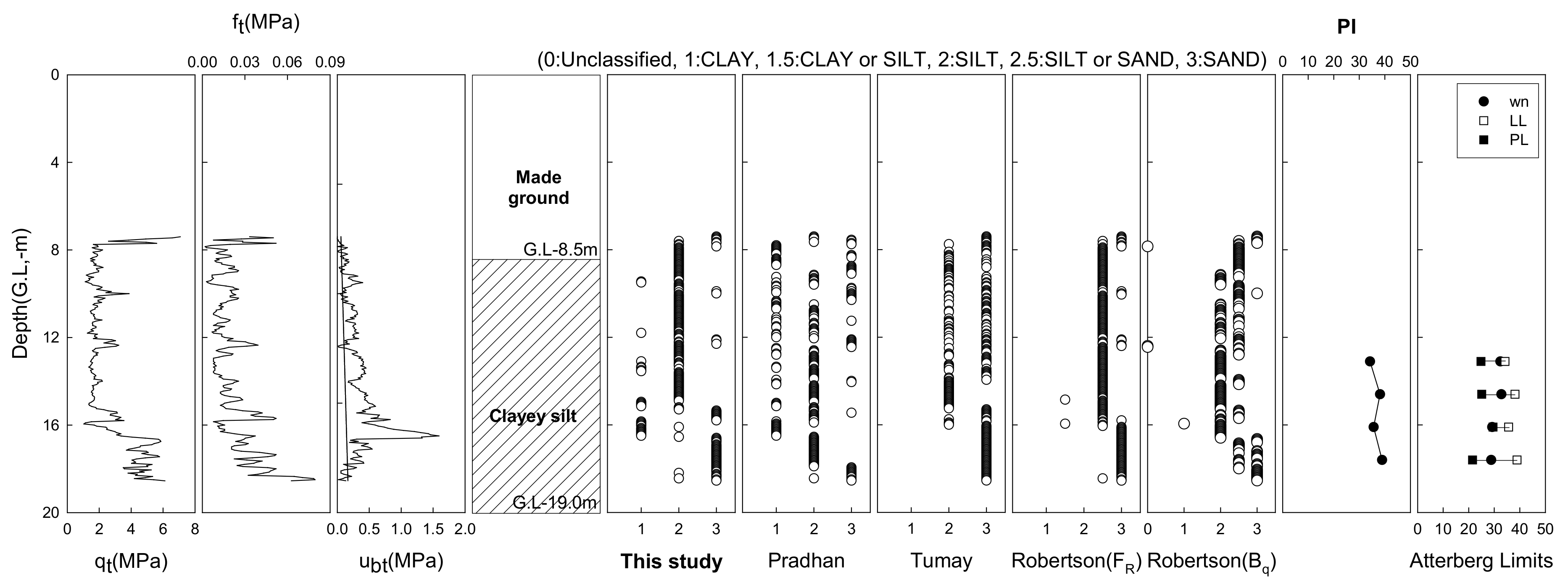
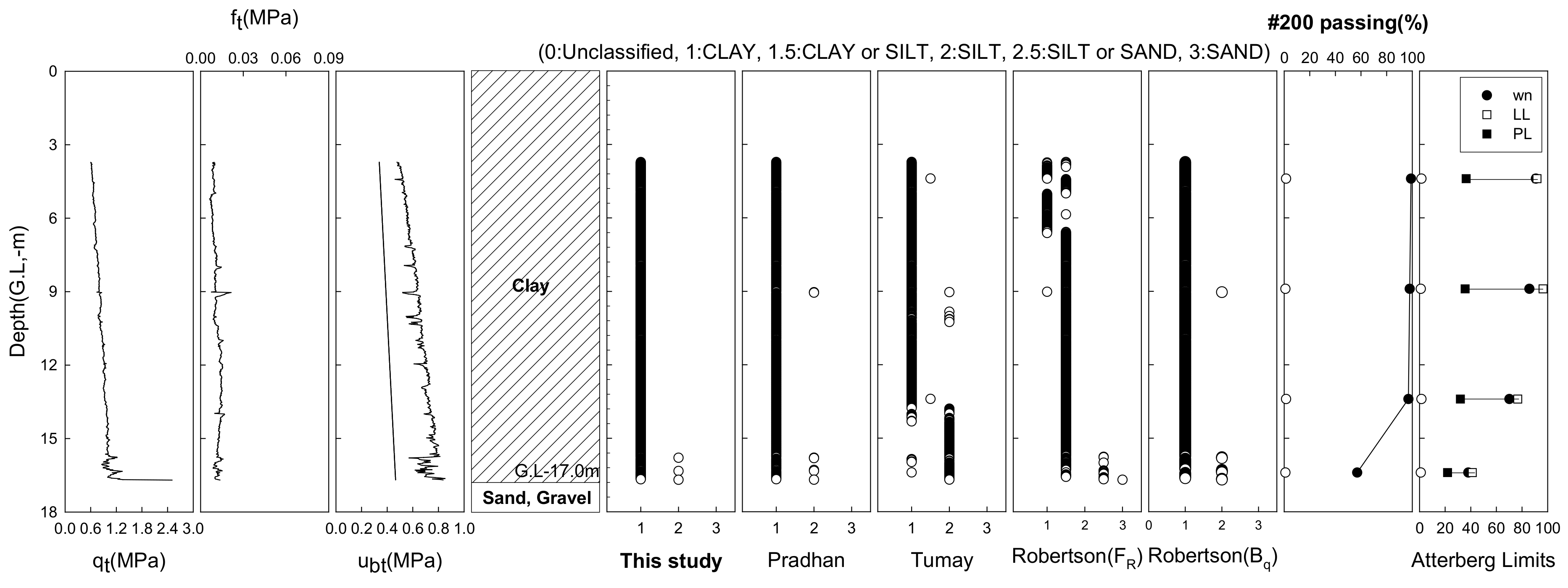
| Sites | Nos. | Soil Type by USCS | |
|---|---|---|---|
| Gyeonggi | Pyeongtaek | 2 | CL, SP, SW |
| Siheung | 3 | CL, SM, SP | |
| Ilsan | 1 | SM, SP | |
| Incheon | 3 | CL, ML | |
| Chungnam | Seocheon | 4 | CL, SM, SP |
| Asan | 1 | CL, SM | |
| Jeonnam | Yeongam | 1 | CH, SP, SW |
| Gwangyang | 1 | CL, CH, ML, SP | |
| Jeonbuk | Kunjang | 9 | CH, CL, ML |
| Gyeongnam | Yangsan | 4 | CL, SM |
| Tongyeong | 2 | CH | |
| Hadong | 2 | CL, CH, MH, SP | |
| Ulsan | 2 | SM, SP-SC | |
| Yongwon | 4 | CH | |
| Cheonseong | 4 | CH | |
| Gaduk | 4 | CH | |
| Kangwon | Naegok | 2 | CL, MH, SP, SW |
| USCS | Nos. | |||
|---|---|---|---|---|
| CH | 2746 | 0.108 to 1.250 | 0.0001 to 0.030 | 0.051 to 0.683 |
| CL | 1861 | 0.028 to 6.520 | 0.0001 to 0.052 | 0.002 to 1.088 |
| MH | 36 | 0.608 to 1.640 | 0.003 to 0.028 | 0.018 to 0.255 |
| ML | 284 | 0.436 to 6.818 | 0.004 to 0.096 | −0.092 to 0.562 |
| SM, SP-SC | 148 | 0.217 to 160.328 | 0.006 to 5.740 | −0.960 to 3.256 |
| SP, SW | 98 | 1.232 to 36.263 | 0.005 to 0.857 | −0.168 to 0.528 |
| Input Parameters | Success Rate (%) | |||
|---|---|---|---|---|
| Three Clusters | Four Clusters | Five Clusters | Six Clusters | |
| 71 | 61 | 46 | Bad | |
| 74 | 60 | 48 | 42 | |
| 70 | 60 | 69 | 42 | |
| 71 | 53 | Bad | 52 | |
| 70 | 58 | 48 | Bad | |
| Selected Fuzzy Membership Functions | Success Rate (%) | |||||
|---|---|---|---|---|---|---|
| Rf | Bq | Clay | Silt | Sand | Average | |
| Triangular | Triangular | Triangular | 99.88 | 60.31 | 75.61 | 78.60 |
| Triangular | Gaussian | 99.43 | 57.19 | 72.76 | 76.46 | |
| Triangular | Bell | 99.58 | 55.31 | 76.83 | 77.24 | |
| Triangular | Sigmoidal | 99.63 | 57.81 | 75.61 | 77.68 | |
| Gaussian | Triangular | 99.85 | 55.06 | 80.49 | 78.80 | |
| Gaussian | Gaussian | 99.43 | 57.19 | 73.58 | 76.73 | |
| Gaussian | Bell | 99.63 | 54.38 | 77.24 | 77.08 | |
| Gaussian | Sigmoidal | 99.58 | 57.19 | 80.49 | 79.09 | |
| Bell | Triangular | 99.38 | 58.44 | 73.98 | 77.27 | |
| Bell | Gaussian | 99.48 | 55.94 | 75.61 | 77.01 | |
| Bell | Bell | 99.63 | 54.06 | 78.46 | 77.38 | |
| Bell | Sigmoidal | 99.60 | 55.94 | 80.89 | 78.81 | |
| Sigmoidal | Triangular | 99.43 | 57.5 | 73.98 | 76.97 | |
| Sigmoidal | Gaussian | 99.48 | 56.25 | 75.61 | 77.11 | |
| Sigmoidal | Bell | 99.58 | 53.13 | 77.24 | 76.65 | |
| Sigmoidal | Sigmoidal | 99.58 | 55.31 | 80.89 | 78.59 | |
| Selected Fuzzy Membership Functions | Success Rate (%) | |||||
|---|---|---|---|---|---|---|
| qt (MPa) | Rf | Bq | Clay | Silt | Sand | Average |
| Gauss | Triangular | Triangular | 99.60 | 57.19 | 73.98 | 76.92 |
| Triangular | Gaussian | 99.65 | 56.25 | 73.98 | 76.63 | |
| Triangular | Bell | 99.43 | 51.25 | 72.36 | 74.35 | |
| Triangular | Sigmoidal | 99.48 | 57.19 | 71.95 | 76.21 | |
| Gaussian | Triangular | Bad | Bad | Bad | Bad | |
| Gaussian | Gaussian | 99.65 | 57.50 | 76.42 | 77.86 | |
| Gaussian | Bell | 99.43 | 52.50 | 76.02 | 75.98 | |
| Gaussian | Sigmoidal | 99.48 | 55.63 | 78.05 | 77.72 | |
| Bell | Triangular | 99.13 | 54.69 | 72.36 | 75.39 | |
| Bell | Gaussian | 99.65 | 57.50 | 76.83 | 77.99 | |
| Bell | Bell | 99.43 | 52.50 | 74.80 | 75.58 | |
| Bell | Sigmoidal | 99.50 | 55.63 | 78.05 | 77.73 | |
| Sigmoidal | Triangular | 99.13 | 55.63 | 67.07 | 73.94 | |
| Sigmoidal | Gaussian | 99.58 | 55.63 | 76.02 | 77.08 | |
| Sigmoidal | Bell | 99.48 | 51.88 | 72.76 | 74.71 | |
| Sigmoidal | Sigmoidal | 99.50 | 55.31 | 76.42 | 77.08 | |
| Selected Fuzzy Membership Functions | Success Rate (%) | |||||
|---|---|---|---|---|---|---|
| qt (MPa) | Rf | Bq | Clay | Silt | Sand | Average |
| Bell | Triangular | Triangular | 98.93 | 53.13 | 63.41 | 71.82 |
| Triangular | Gaussian | 99.60 | 55.00 | 72.76 | 75.79 | |
| Triangular | Bell | 99.50 | 53.13 | 73.58 | 75.40 | |
| Triangular | Sigmoidal | 99.43 | 57.19 | 69.51 | 75.38 | |
| Gaussian | Triangular | Bad | Bad | Bad | Bad | |
| Gaussian | Gaussian | 99.73 | 57.50 | 77.64 | 78.29 | |
| Gaussian | Bell | 99.58 | 55.31 | 78.46 | 77.78 | |
| Gaussian | Sigmoidal | 99.45 | 55.31 | 77.24 | 77.33 | |
| Bell | Triangular | 99.80 | 54.06 | 80.89 | 78.25 | |
| Bell | Gaussian | 99.60 | 55.94 | 75.61 | 77.05 | |
| Bell | Bell | 99.50 | 54.69 | 75.61 | 76.60 | |
| Bell | Sigmoidal | 99.48 | 54.38 | 76.42 | 76.76 | |
| Sigmoidal | Triangular | 98.98 | 55.63 | 65.04 | 73.22 | |
| Sigmoidal | Gaussian | 99.58 | 54.06 | 76.83 | 76.82 | |
| Sigmoidal | Bell | 99.45 | 50.31 | 71.14 | 73.63 | |
| Sigmoidal | Sigmoidal | 99.48 | 54.69 | 72.36 | 75.51 | |
| Selected Fuzzy Membership Functions | Success Rate (%) | |||||
|---|---|---|---|---|---|---|
| qt (MPa) | FR | Bq | Clay | Silt | Sand | Average |
| Sigmoidal | Triangular | Triangular | 99.50 | 59.38 | 74.39 | 77.76 |
| Triangular | Gaussian | 99.63 | 52.81 | 73.17 | 75.20 | |
| Triangular | Bell | 99.58 | 47.81 | 75.20 | 74.20 | |
| Triangular | Sigmoidal | 99.53 | 53.75 | 75.20 | 76.16 | |
| Gaussian | Triangular | 99.50 | 60.31 | 76.42 | 78.74 | |
| Gaussian | Gaussian | 99.60 | 53.44 | 74.80 | 75.95 | |
| Gaussian | Bell | 99.58 | 51.88 | 76.42 | 75.96 | |
| Gaussian | Sigmoidal | 99.55 | 52.81 | 76.83 | 76.40 | |
| Bell | Triangular | 99.53 | 59.06 | 78.46 | 79.02 | |
| Bell | Gaussian | 99.55 | 53.44 | 74.39 | 75.79 | |
| Bell | Bell | 99.58 | 52.50 | 74.80 | 75.63 | |
| Bell | Sigmoidal | 99.55 | 52.81 | 75.61 | 75.99 | |
| Sigmoidal | Triangular | 99.55 | 59.06 | 78.05 | 78.89 | |
| Sigmoidal | Gaussian | 99.60 | 52.50 | 77.24 | 76.45 | |
| Sigmoidal | Bell | 99.55 | 53.75 | 74.80 | 76.03 | |
| Sigmoidal | Sigmoidal | 99.55 | 52.81 | 73.98 | 75.45 | |
Publisher’s Note: MDPI stays neutral with regard to jurisdictional claims in published maps and institutional affiliations. |
© 2022 by the authors. Licensee MDPI, Basel, Switzerland. This article is an open access article distributed under the terms and conditions of the Creative Commons Attribution (CC BY) license (https://creativecommons.org/licenses/by/4.0/).
Share and Cite
Moon, J.-S.; Kim, C.-H.; Kim, Y.-S. Soil Classification from Piezocone Penetration Test Using Fuzzy Clustering and Neuro-Fuzzy Theory. Appl. Sci. 2022, 12, 4023. https://doi.org/10.3390/app12084023
Moon J-S, Kim C-H, Kim Y-S. Soil Classification from Piezocone Penetration Test Using Fuzzy Clustering and Neuro-Fuzzy Theory. Applied Sciences. 2022; 12(8):4023. https://doi.org/10.3390/app12084023
Chicago/Turabian StyleMoon, Joon-Shik, Chan-Hong Kim, and Young-Sang Kim. 2022. "Soil Classification from Piezocone Penetration Test Using Fuzzy Clustering and Neuro-Fuzzy Theory" Applied Sciences 12, no. 8: 4023. https://doi.org/10.3390/app12084023
APA StyleMoon, J.-S., Kim, C.-H., & Kim, Y.-S. (2022). Soil Classification from Piezocone Penetration Test Using Fuzzy Clustering and Neuro-Fuzzy Theory. Applied Sciences, 12(8), 4023. https://doi.org/10.3390/app12084023






